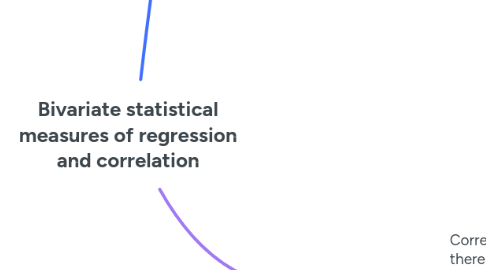
1. Regression
1.1. In regression analysis it is a tool frequently used in statistics that allows to investigate the relationships between different quantitative dependent variables, regression analysis is a process or model that analyzes the link between a dependent variable and one or several independent variables.
1.1.1. objective
1.1.1.1. -The regression analysis is to build a function that allows estimating the future value of the study variable. -The regression allows to calculate a conditional (average) expectation
1.1.2. variable types
1.1.2.1. Covariates or Independent Variables or Regressor Variables
1.1.2.1.1. Are they used as predictors or are confounding variables that are of interest to control
1.1.2.2. Outcome or Independent Variables or Regressor Variables
1.1.2.2.1. measure changes or make predictions.
2. Correlation
2.1. Correlation refers to the fact that there is a link between various events. One of the tools that allows us to infer whether such a link exists is precisely the correlation analysis.
2.1.1. objective
2.1.1.1. tell us if there is a relationship between two events –that is, variables–, a little about the nature of said relationship, and its strength.
2.1.2. correlation types
2.1.2.1. Direct correlation: Direct correlation occurs when increasing one of the variables the other increases. The line corresponding to the cloud of points of the distribution is a growing line.
2.1.2.2. Inverse correlation: The inverse correlation occurs when one of the variables increases, the other decreases. The line corresponding to the cloud of distribution points is a decreasing line
2.1.2.3. Null correlation: Null correlation occurs when there is no dependency of any kind between the variables. In this case it is said that the variables are uncorrelated and the cloud of points has a rounded shape.
2.1.3. Correlation Coefficient Statistical correlation is measured by what is called the correlation coefficient (r). Its numerical value ranges from 1.0 to -1.0. It indicates the strength of the relationship. In general, r > 0 indicates a positive relationship and r < 0 indicates a negative relationship, while r = 0 indicates no relationship (or the variables are independent and unrelated). Here, r = 1.0 describes a perfect positive correlation and r = -1.0 describes a perfect negative correlation.
2.1.4. Degrees of correlation
2.1.4.1. strong correlation: the correlation is stronger the closer the points are to the line.
2.1.4.2. weak correlation: the correlation is weak, the further apart the points are on the line.
2.1.4.3. null correlation: here there is no type of pattern or relationship between them.
